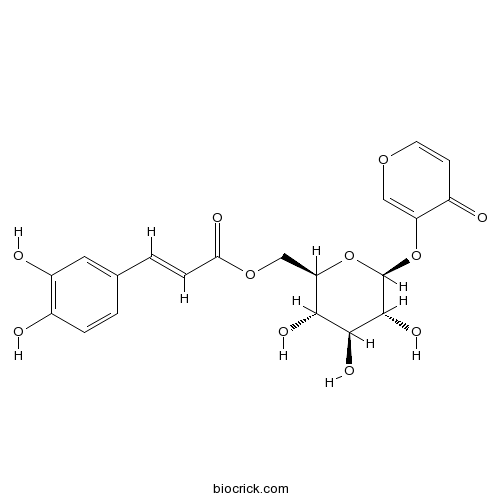Erigeside ICAS# 224824-74-2 |

Quality Control & MSDS
3D structure
Package In Stock
Number of papers citing our products

| Cas No. | 224824-74-2 | SDF | Download SDF |
| PubChem ID | 5315605 | Appearance | Powder |
| Formula | C20H20O11 | M.Wt | 436.36 |
| Type of Compound | Phenols | Storage | Desiccate at -20°C |
| Solubility | Soluble in Chloroform,Dichloromethane,Ethyl Acetate,DMSO,Acetone,etc. | ||
| Chemical Name | [(2R,3S,4S,5R,6S)-3,4,5-trihydroxy-6-(4-oxopyran-3-yl)oxyoxan-2-yl]methyl (E)-3-(3,4-dihydroxyphenyl)prop-2-enoate | ||
| SMILES | C1=CC(=C(C=C1C=CC(=O)OCC2C(C(C(C(O2)OC3=COC=CC3=O)O)O)O)O)O | ||
| Standard InChIKey | CLFSHBHNICRSDA-ROGMSIAGSA-N | ||
| Standard InChI | InChI=1S/C20H20O11/c21-11-3-1-10(7-13(11)23)2-4-16(24)29-9-15-17(25)18(26)19(27)20(31-15)30-14-8-28-6-5-12(14)22/h1-8,15,17-21,23,25-27H,9H2/b4-2+/t15-,17-,18+,19-,20-/m1/s1 | ||
| General tips | For obtaining a higher solubility , please warm the tube at 37 ℃ and shake it in the ultrasonic bath for a while.Stock solution can be stored below -20℃ for several months. We recommend that you prepare and use the solution on the same day. However, if the test schedule requires, the stock solutions can be prepared in advance, and the stock solution must be sealed and stored below -20℃. In general, the stock solution can be kept for several months. Before use, we recommend that you leave the vial at room temperature for at least an hour before opening it. |
||
| About Packaging | 1. The packaging of the product may be reversed during transportation, cause the high purity compounds to adhere to the neck or cap of the vial.Take the vail out of its packaging and shake gently until the compounds fall to the bottom of the vial. 2. For liquid products, please centrifuge at 500xg to gather the liquid to the bottom of the vial. 3. Try to avoid loss or contamination during the experiment. |
||
| Shipping Condition | Packaging according to customer requirements(5mg, 10mg, 20mg and more). Ship via FedEx, DHL, UPS, EMS or other couriers with RT, or blue ice upon request. | ||
| Description | 1. Erigeside I is a radical scavenger. |

Erigeside I Dilution Calculator

Erigeside I Molarity Calculator
| 1 mg | 5 mg | 10 mg | 20 mg | 25 mg | |
| 1 mM | 2.2917 mL | 11.4584 mL | 22.9169 mL | 45.8337 mL | 57.2921 mL |
| 5 mM | 0.4583 mL | 2.2917 mL | 4.5834 mL | 9.1667 mL | 11.4584 mL |
| 10 mM | 0.2292 mL | 1.1458 mL | 2.2917 mL | 4.5834 mL | 5.7292 mL |
| 50 mM | 0.0458 mL | 0.2292 mL | 0.4583 mL | 0.9167 mL | 1.1458 mL |
| 100 mM | 0.0229 mL | 0.1146 mL | 0.2292 mL | 0.4583 mL | 0.5729 mL |
| * Note: If you are in the process of experiment, it's necessary to make the dilution ratios of the samples. The dilution data above is only for reference. Normally, it's can get a better solubility within lower of Concentrations. | |||||

Calcutta University

University of Minnesota

University of Maryland School of Medicine

University of Illinois at Chicago

The Ohio State University

University of Zurich

Harvard University

Colorado State University

Auburn University

Yale University

Worcester Polytechnic Institute

Washington State University

Stanford University

University of Leipzig

Universidade da Beira Interior

The Institute of Cancer Research

Heidelberg University

University of Amsterdam

University of Auckland

TsingHua University

The University of Michigan

Miami University

DRURY University

Jilin University

Fudan University

Wuhan University

Sun Yat-sen University

Universite de Paris

Deemed University

Auckland University

The University of Tokyo

Korea University
- Vardenafil HCl Trihydrate
Catalog No.:BCC2277
CAS No.:224785-90-4
- 18-Norabieta-8,11,13-trien-4-ol
Catalog No.:BCN5064
CAS No.:22478-65-5
- Gymnemagenin
Catalog No.:BCN7841
CAS No.:22467-07-8
- MLCK inhibitor peptide 18
Catalog No.:BCC5828
CAS No.:224579-74-2
- Benfotiamine
Catalog No.:BCC1415
CAS No.:22457-89-2
- Retapamulin
Catalog No.:BCC4837
CAS No.:224452-66-8
- Ginsenoside Rg1
Catalog No.:BCN1066
CAS No.:22427-39-0
- Bayogenin methyl ester
Catalog No.:BCN3722
CAS No.:22425-81-6
- 2,2'-Anhydro-5-methyluridine
Catalog No.:BCC8486
CAS No.:22423-26-3
- Incensole
Catalog No.:BCN3831
CAS No.:22419-74-5
- Siramesine hydrochloride
Catalog No.:BCC5134
CAS No.:224177-60-0
- 3-Epiturraeanthin
Catalog No.:BCN5063
CAS No.:22415-24-3
- N-(1-hydroxy-2-(hydroxymethyl)-4-(4-octylphenyl)butan-2-yl)acetamide
Catalog No.:BCN1483
CAS No.:2249289-10-9
- IDRA 21
Catalog No.:BCC6974
CAS No.:22503-72-6
- Falcarindiol
Catalog No.:BCN5065
CAS No.:225110-25-8
- Cathepsin Inhibitor 1
Catalog No.:BCC4896
CAS No.:225120-65-0
- 8-Hydroxy-9,10-diisobutyryloxythymol
Catalog No.:BCN7786
CAS No.:22518-08-7
- CTU Guanamine
Catalog No.:BCC8921
CAS No.:22535-90-6
- Ocotillone
Catalog No.:BCN5066
CAS No.:22549-21-9
- Robustine
Catalog No.:BCN6653
CAS No.:2255-50-7
- Isocryptotanshinone
Catalog No.:BCN2499
CAS No.:22550-15-8
- Bisabolol Oxide A
Catalog No.:BCC8133
CAS No.:22567-36-8
- Zeorin
Catalog No.:BCN5067
CAS No.:22570-53-2
- Symphytine
Catalog No.:BCN1975
CAS No.:22571-95-5
Screening of free radical scavengers from Erigeron breviscapus using on-line HPLC-ABTS/DPPH based assay and mass spectrometer detection.[Pubmed:22239535]
Free Radic Res. 2012 Mar;46(3):286-94.
Erigeron breviscapus is a well-known traditional Chinese herbal medicine. In this study, on-line HPLC-ABTS/DPPH assay coupled with MS detection were applied to screen and identify the free radical scavengers in 70% methanol extracts of E. breviscapus. Using on-line HPLC-ABTS-MS and HPLC-DPPH-MS assay, 13 radical scavengers (including 4-O-caffeoylquinic acid (4-CQA) (1), 9-caffeoyl-2,7-anhydro-2-octulosonic acid (9-COA) (2), 3-caffeoyl-2,7-anhydro-3-deoxy-2-octulopyranosonic acid (3-CDOA) (3), Erigeside I (4), quercetin-3-O-glucuronide (5), eriodictyol-7-O-glucuronide (6), scutellarin (7), 1,4-di-O-caffeoylquinic acid (1,4-di-CQA) (8), 3,5-di-CQA (9), 1-malonyl-3,5-di-CQA (10), erigoster B (11), 4,5-di-CQA (12) and 4,9-di-CDOA (13)) and 9 radical scavengers (including 1, 4, 7, 8, 9, 10, 11, 12 and 13) were discovered, respectively. Furthermore, the anti-oxidative activities of 4 compounds, including 7, 9, 11 and 12 were evaluated. Reverse anti-oxidative activity order of scutellarin and 3,5-di-CQA was observed in on-line HPLC-ABTS assay and on-line HPLC-DPPH assay. To validate their anti-oxidative activities, the off-line ABTS and DPPH assays were performed. Given sufficient reaction time, 3,5-di-CQA showed higher activity than scutellarin, which was consistent with the order obtained in on-line HPLC-ABTS assay. These results revealed that on-line HPLC-ABTS assay is a more sensitive method for screening and determining free radical scavengers, especially more suitable for those compounds with slower reaction kinetics.


